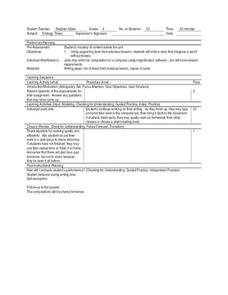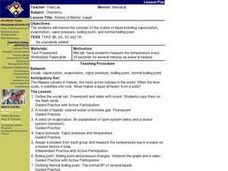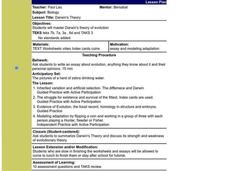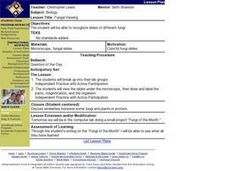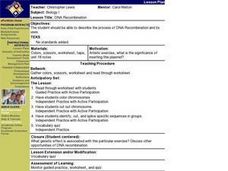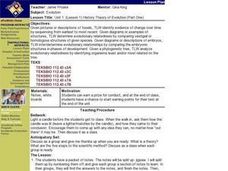Curated OER
Designing Our Own Inventions
Third graders use research from a previous activity to design their own inventions. In groups, they brainstorm a product they would like to see built and share them with the class. They must explain how each one would serve a purpose or...
Curated OER
Ecology: Trees
Fourth graders read the defintions of renewale and nonrenewable resources and discuss any incorrect responses. They view a sample of work for the class to see which they describe posting responses on the board in their respective columns...
Curated OER
Ecology: Trees
Fourth graders, while working in the classroom and the computer lab, utilizing supporting facts from previous lessons, write a creative story that imagines a world without forests. They write, type and print their stories and turn them...
Curated OER
States of Matter: Liquid
Pupils work in a mini lab where they measure the temperature every 30 seconds for several minutes as water is heated. They are asked what makes liquid different from a solid. Students view a PowerPoint on the model of liquids, colored...
Curated OER
Evolution
Students investigate the concept of evolution and its implications upon the origin and development of life. They conduct research using a variety of resources while focusing upon cross-over and mutations. The information is used to set...
Curated OER
The Joy of a Garden
Students study environmental stewardship. In this environmental stewardship instructional activity, students read the story The Gardner and define the character's actions for the environment. Students define philanthropy and...
Curated OER
Old MacDonald Had a Farm
Students complete various activities to investigate farm animals. In this farm animals lesson, students sing the song 'Old MacDonald Had a Farm,' and listen to sounds farm animals make. Students color pictures for farm animals and...
Curated OER
Feel the Wonder
Students describe why clean water is important and how humans effect the quality of water in a community. They identify efforts in their community to keep the water clean. They participate in a water restoration movement in their area...
Curated OER
Habitats
Students are introduced to various animals and their habitats. In groups, they must determine which animal skin matches the correct animal and identify the texture. They discuss the reason for the texture and width of the skin to end...
Curated OER
Vitamin Planet
Students explain the function of vitamins in their body. In this health lesson plan, students identify the six types of vitamins. They create a chart comparing two of them.
Curated OER
Rock and Roll!
Students predict what happen to the rocks. They observe, describe, and record changes in rocks. They apply their learning by describing the forces that break down and wear away rocks.
Curated OER
Balancing Bottles
Students explore the Law of Conservation of Matter using effervescent tablets. In this mass and energy lesson, students investigate how mass is conserved in the reaction of effervescent tablets and water. They will discuss and...
Curated OER
Genes
Students discuss the difference between a gene, DNA, chromatid, and chromosome. They predict how changes in chromosome number or structure affect development. Students discuss what causes genetic disorders. They view a PowerPoint that...
Curated OER
Darwin's Theory
Pupils write an essay about evolution. They summarize Darwin's Theory and discuss its strength and weakness of evolutionary theory. Students discuss the struggle of existence and survival of the fittest. They discuss the evidence of...
Curated OER
Fungal Viewing
Pupils recognize slides of different fungi. They work in lab groups. Students view slides under the microscope, then draw and label the parts, magnification, and the organism. Pupils discuss similarities between some fungi and plants...
Curated OER
Foul Water Lab
Students use field practices to clean foul water, they comprehend the differences in solution and solutes. They work in groups and discuss the lab instructions. Students start with oil-water separation technique. They complete a...
Curated OER
DNA Recombination II
Students model recombination in DNA. They color the DNA sample and cut it out. Students use their "restriction enzymes" to cut the DNA into specific fragments. They separate the fragments using the "gel electrotrophoresis." Students...
Curated OER
DNA Recombination
Students describe the process of DNA Recombination and its uses. They are asked what genetic effect is associated with the exercise? Students discuss other opportunities of DNA recombination. They are given a worksheet, and students...
Curated OER
Evolution
Students illustrate the results of natural selection by identifying the specific adaptation of an organism that allows the species to survive in that environment. They illustrate the results of natural selection by recognizing examples...
Curated OER
History Theory of Evolution
Students identify fossils. They identify evidence of change over time when given pictures of fossils to determine the proper sequencing. In addition, they determine evolutionary relationships by comparing embryonic structures.
Curated OER
Water World
Students explore the various steps of the water cycle. They identify the three steps in the water cycle and how they are related. Students describe three ways to conserve water. Students explore the origin of the water source that...
Curated OER
How Cells Reproduce
Young scholars construct a mitosis flip book. For this biology lesson, students describe the different stages of mitosis. They discuss the importance of cell reproduction.
Curated OER
Adaptations To the Environment
Learners design and construct an imaginary animal that is perfectly adapted to a particular type of biome. They give the animal a scientific name, place it in a phylum and write descriptions about its behavior, reproduction, foraging,...
Curated OER
Ecosystems and Symbiotic Relationships
Students are told to create a community using words or pictures. They walk outside to an area in front of the school which has a strip of grass, ditch, and corn field. Students discuss the difference between an ecosystem and a...




